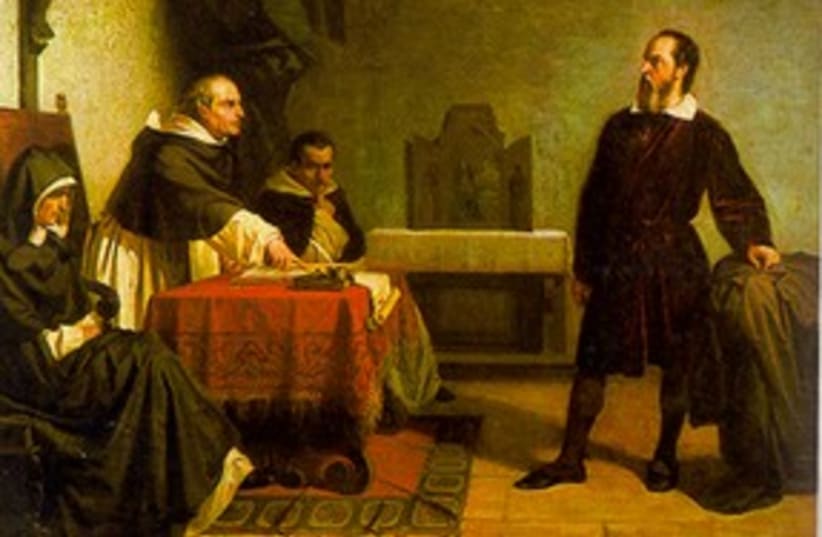On September 20, 1633, the Italian scientist Galileo Galilei is tried by theChurch for teaching that the Earth orbits the sun. As a result, on the Pope’sorder, he was confined to house arrest for the remainder of his life until hisdeath in 1642, at the age of 77.
One century earlier, Nicolaus Copernicus had published Onthe Revolutions of the Celestial Spheres, the first book to outline acomprehensive heliocentric cosmology. This revolutionary theory placed the sunat center of the universe, rather than the Earth.
Geocentricism, the theory placing the Earth at the center ofthe Universe, had been vastly accepted since the 2nd century AD,when firmly established by Claudius Ptolemy.
What is known as the “Galileo affair” began in 1610 when hecame out against the Ptolemaic scientific view in his book Starry Messenger.Using the new telescope he had developed, he made observations supportingCopernican astronomy.
In reaction, many scientific and theological scholarsattacked the theory because it seemingly contradicted Ptolemy's model of theuniverse, as well as several passages of Holy Scripture.
Galilei responded to that criticism in his letter to Keplerin August 1610 saying “My dear Kepler, I wish that we might laugh at theremarkable stupidity of the common herd. What do you have to say about theprincipal philosophers of this academy who are filled with the stubbornness ofan asp and do not want to look at either the planets, the moon or thetelescope, even though I have freely and deliberately offered them theopportunity a thousand times? Truly, just as the asp stops its ears, so dothese philosophers shut their eyes to the light of truth.”
While Church officials were willing to let heliocentrism betaught as a hypothesis and discussed in scientific circles, the faith of theordinary people was to be safeguarded. However, Galilei argued that histelescopic observations favored the Copernican heliocentric theory as aphysical truth.
As the Inquisition started taking serious notice ofGalilei’s work in 1615, he sent a letter to Grand Duchess Christina, which wasan essay on the relation between the revelations of the Bible and the newdiscoveries then being made in science. His general stance was that therelevant passages of the Bible, which he was accused of contradicting, shouldnot be interpreted literally, especially when taken from poetic or allegoricaltexts.
By 1616, the attacks on Copernicus’ ideas had reached a peak,to which Galilei responded by going to Rome in order to persuade the CatholicChurch authorities not to ban heliocentrism. Ultimately, the Inquisitiondelivered him with an order not to "hold or defend" the idea that theEarth moves and the Sun stands still at the centre. The decree did not preventGalileo from discussing the controversial subject.
Pope Urban VIII, elected in 1623, was a friend and supporterof Galilei who opposed his condemnation in 1616. And thus, with the Pope’s formalauthorization along with that of the Inquisition, Galilei published DialogueConcerning the Two Chief World Systems in 1632. Previously, the Pope hadpersonally asked Galilei to give arguments for and against heliocentrism in thebook, and to be careful not to advocate the controversial theory. He alsorequested that his own views on the matter be included in Galileo's book. Onlythe latter of those requests was fulfilled by Galilei.
Whether unknowingly or deliberately, Simplicio, the defenderof the Geocentric view in the book, was often caught in his own errors andsometimes came across as a fool. Indeed, although Galileo states in the prefaceof his book that the character is named after a famous Aristotelianphilosopher, the name "Simplicio" in Italian also has the connotationof "simpleton.” This portrayal of Simplicio made it appear as anadvocacy book: an attack on Aristotelian geocentrism and defence of theCopernican theory.
Unfortunately for his relationship with the Pope, Galileoput the words of Urban VIII into the mouth of Simplicio. Most historians agreeGalilei did not act out of malice and felt blindsided by the reaction to hisbook.
However, the Pope did not take the suspected public ridiculelightly, nor the Copernican advocacy. Galileo had alienated one of his biggestand most powerful supporters, the Pope, and was called to Rome to defend his writings.
With the loss of many of his defenders in Rome because of Dialogue Concerning theTwo Chief World Systems, Galilei was ordered to stand trial on suspicion ofheresy in 1633.
As a result, Galilei was found “vehemently suspect ofheresy” and was required to "abjure, curse and detest" thoseopinions. He was sentenced to formal imprisonment at the pleasure of theInquisition. On the following day, this was commuted to house arrest, which heremained under for the rest of his life.
Aside from his theoretical works, Galilei made severalcontributions to “technology” such as an improved telescope, a thermometer, a militarycompass and many many others. So great was his legacy that he was called byEinstein the “father of modern science.”
